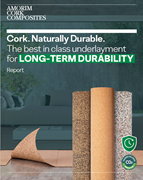Long-term Durability
Why choose a cork-based underlayment instead of a 100% foam solution?
Cork underlayments are more durable over time compared to foam-based solutionsCork underlayments are more durable over time compared to foam-based solutions
Comparative tests show that cork underlayments ensure greater durability over time, compared to foam-based products in the same category. In addition to prolonging the floor’s initial characteristics and performance, cork underlayments deliver greater savings for the end consumer, avoiding the need for an early replacement of the floor.
According to a survey recently conducted by Amorim Cork Composites, durability is the performance characteristic that is most highly valued by consumers who are planning to install, or have recently installed new flooring, in their homes.
Why choose a cork-based underlayment instead of a 100% foam solution? To help you answer that, we ran the following tests...
Two comparative tests were conducted between cork underlayments and 100% foam underlayments, in order to assess the durability of cork-based solutions vs. synthetic solutions from the same category. The results of the Dynamic Load Test and the Compressive Creep Test revealed that cork underlayments are the best option to guarantee the floor’s durability and performance over a long period of time, compared to foam-based solutions.
In this manner, choosing a cork-based solution delivers savings for the end consumer, thereby avoiding the need for an early replacement of the floor. With cork-based solutions, users can enjoy the comfort offered by an underlayment for many years, just like the first day! In addition to offering reliable performance, cork underlayments are also a more sustainable choice from an environmental perspective, compared to foam-based solutions.
Considering Amorim's wide range of underlayments, independent studies carried out by the consultancy firm EY concluded that all the analyzed products have a negative carbon balance, when considering carbon sequestration from cork oak forests and production-related emissions. This means that the cork-based underlayment promotes carbon sequestration in the cork oak forest that exceeds the CO2 emissions from its production.
Dynamic Load Test (CS)*
The Dynamic Load Test is conducted in a laboratory. It simulates the pressure exerted on the floor, caused by the movement of people, suitcases with wheels (trolleys) and office chairs with castors, among others. To be effective, the underlayment must be able to withstand such pressure without losing its absorption characteristics.
To assess the performance of the materials, a sample of a cork underlayment and another made entirely of foam, both 10 mm thick, were subjected to 100,000 cycles of 75 kPa of pressure.
*test conducted in an independent certified laboratory.
Result
The cork underlayment demonstrated a clearly superior performance when compared to the 100% foam-based solution and maintained its characteristics. After 100,000 load cycles, the cork underlayment lost only 5% of its thickness, while the foam-based solution lost 55%.
Compressive Creep Test (CC)*
The Compressive Creep Test determines the weight that can be placed on a given floor over time, with a 10-year period as reference. For example, the weight of furniture.
In a comparative test between a cork sample and a 100% foam-based sample, the cork-based solution, due to its resilience, demonstrated higher resistance to compressive creep. In other words, cork maintains almost the same thickness while compressed over time, with less than a 10% loss in thickness and, consequently, maintains the system’s performance when applied.
In a comparative test between a cork sample and a 100% foam-based sample, the cork-based solution, due to its resilience, demonstrated higher resistance to compressive creep. In other words, cork maintains almost the same thickness while compressed over time, with less than a 10% loss in thickness and, consequently, maintains the system’s performance when applied. In the case of foam-based solutions (PE, XPS or PP), whenever the underlayment is pressed this causes the cells to break, which resulted in 30% less thickness, and consequently lower density and effectiveness.
*test made at i.Cork Factory press (not in accordance with creep standard).
Results
Cork has higher compressive creep due to its inherent resilience. This means that cork does not completely lose its thickness after being compressed and preserves the technical properties where it is applied. By contrast, the cells of several standard foams suffer damage when subjected to the same loads.
So, if you’re looking for a solution that will deliver long-term durability for your floor - choose a cork-based underlayment!
Long-Term Durability
Take a look for yourself on how cork underlayments perform when compared to foam!
